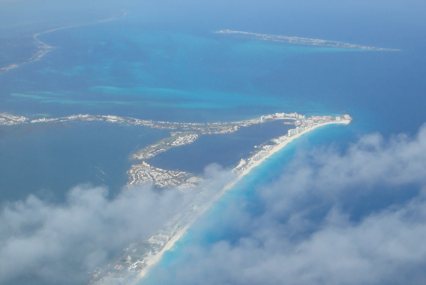CANCUN, Mexico — Yesterday, top diplomats from around the world flew into Cancun to make a final push for progress on in waning days of the 16th meeting of the Conference of the Parties (COP 16) to the UN Framework Convention on Climate Change (UNFCCC). What they saw as their planes prepared to land at Aeropuerto Internacional de Cancún may help sharpen their resolve and encourage countries to make a deal.
Cancun is not only picturesque, it is also at tremendous risk if climate change continues unabated. The resorts hang down from the central city like a string of pearls dangling in the teal waters of the Atlantic. Separating the city from the resorts is Laguna Nichupté. Much of the area around Cancun is also filled with similar tropical, swamp-like scrub land.
Rising, acidifying oceans and stronger storms could ruin all that beauty. The shiny, aquamarine waters off its coast would become tarnished if the coral providing their beautiful hue is bleached by ocean acidification. Without these coral reefs, its world famous hotels would also be at risk. A sea level rise of only a few inches, coupled with the loss of protective coral and more vicious storms, could devastate Cancun’s fragile coastline.
There’s already evidence of climate change’s impact on the city. The sandy beach in front of many of the hotels are receding due to increasingly stronger storm surges. The biggest of all came with Hurricane Wilma, which battered the city in 2005. It cost Mexico $7.5 billion and it was only a category three storm.
Now on the ground, ensconced in the luxurious Moon Palace hotel, diplomats would do well to remember the view from the air. If the COP 16 talks in Cancun fail, it may spell not only the end of the UNFCCC process, but also perhaps the city itself.
